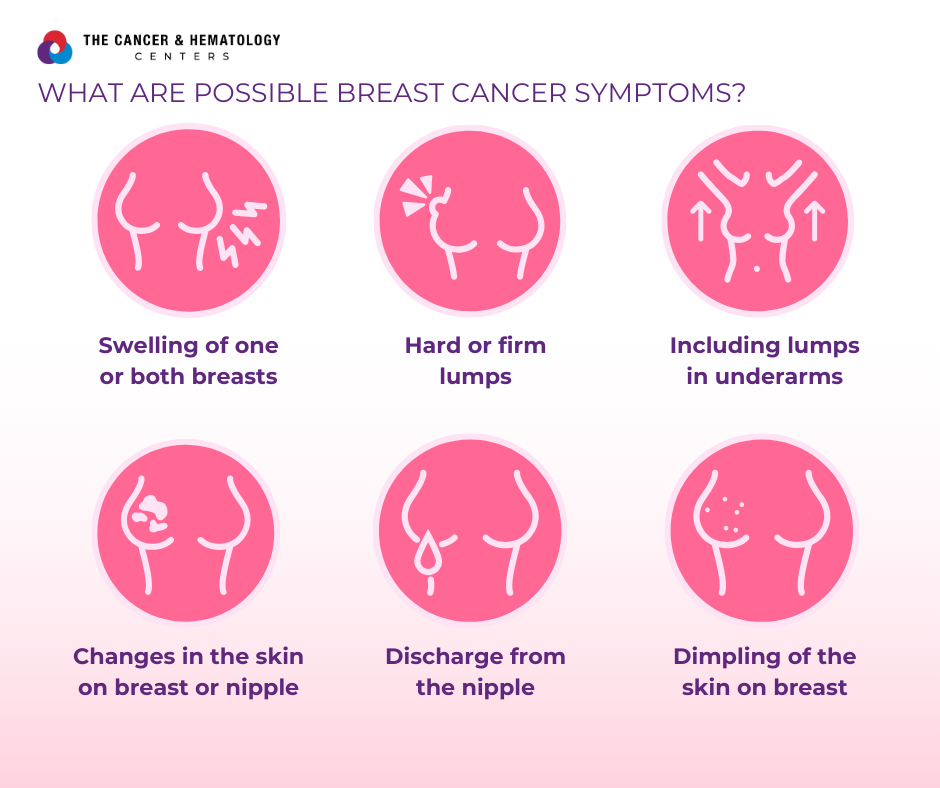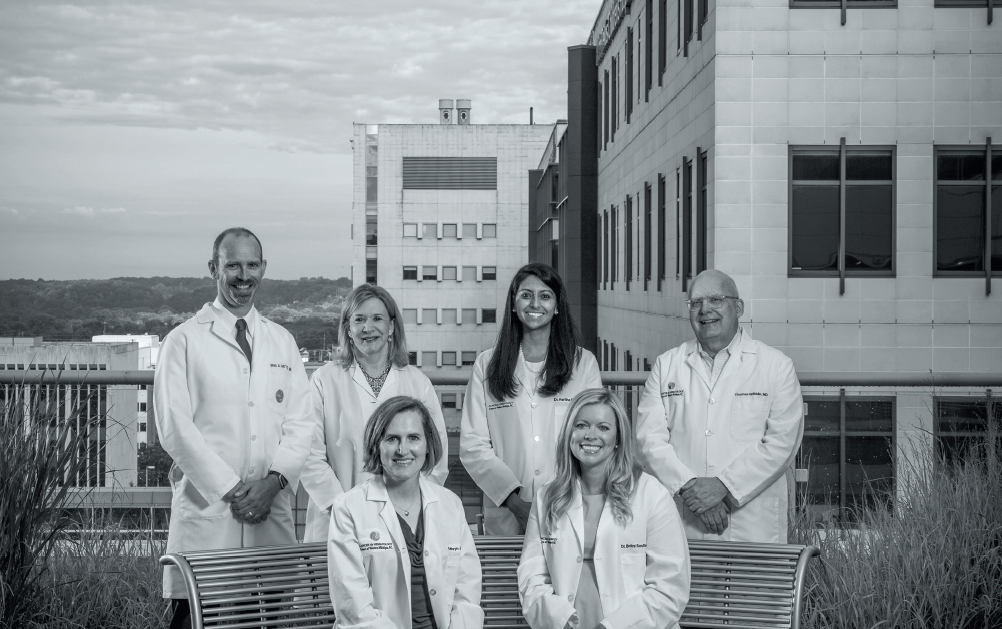Any diagnosis of cancer, including breast cancer, can be life-changing. Fortunately, most patients with breast cancer are cured and there are many options for treatment to control the disease and to focus on living your best life.
Explore this primer on breast cancer, to have a better understanding of the different types and the breast cancer treatment options available.
Breast Cancer Symptoms
Most patients with breast cancer have no symptoms and only receive a diagnosis when a mammogram detects it. If a patient has symptoms, it could be a new lump or mass appearing in your breast tissue.
Other signs of breast cancer include the following symptoms:
- Swelling of one or both breasts
- Discharge from the nipple
- Dimpling of the skin on your breast
- Nipple turning inward
- Hard or firm lumps, including under the arm or near the collarbone
- Changes in the skin on the breast or nipple

It’s important to know that some of these symptoms are not exclusive to breast cancer. In fact, some of
them can be associated with far less serious conditions. No matter what you think these symptoms might mean, it’s important to talk to your doctor about your concerns.
Types of Breast Cancer and Staging
Breast cancer treatment is based on the cancer’s subtype.
Some breast cancers are hormone-positive, meaning the cells have receptors for the hormones estrogen and progesterone, which bind to the cancer and stimulate growth. Nearly two-thirds of breast cancers are hormone-positive.
Another subtype is HER2-positive. In this case, the cancer has extra copies of this gene and it is the driver of the cancer. Some tumors are positive for hormone receptors and HER2. Lastly, there is the triple-negative subtype, meaning the testing is negative for hormone receptors and there is no increase in the HER2 gene.
The staging of breast cancer includes the size of the cancer and if it has spread to local lymph nodes (under the arm) as well as other features of the cancer. These include the grade, markers for estrogen and progesterone receptors, and HER2 status.
Stage 0
If the breast cancer is only within the ducts and hasn’t spread to other tissue, it is considered stage 0 breast cancer, or noninvasive.
Stage I
The tumor is small and has not spread to the lymph nodes, or there is minimal lymph node involvement with low risk features (strongly hormone positive and low grade).
Stage II
The tumor is larger and involves lymph nodes, but it has low risk features—like low grade and strong hormone positivity. Or, the tumor is triple negative (negative for estrogen, progesterone, and HER2 testing) and larger than 2 centimeters.
Stage III
Stage III breast cancer for hormone-positive cancer or HER2-positive tumors includes cancer that has spread to several lymph nodes (more than four, or more than nine with a smaller tumor). A stage III tumor for triple-negative breast cancer includes a large tumor with no lymph node involvement or any size tumor with lymph node involvement.
Stage IV
Also called metastatic breast cancer, this cancer includes a tumor of any size. In Stage IV breast cancer, the disease has spread to other organs and tissues, including the bones, lungs, brain, and liver.
Breast Cancer Treatment Options
The type of breast cancer treatment you receive depends on the stage, and the specific markers of the cancer—such as estrogen and progesterone receptors, and HER-2 status.
For localized disease, the treatment is surgery and possibly radiation therapy to the breast. Systemic therapy is then considered to increase the chance of a cure, with the goal of killing micrometastatic disease. These systemic therapies include hormone blockers, chemotherapy, or immunotherapy depending on the subtype of breast cancer.
Surgery
For most breast cancer patients, surgery is the first treatment their cancer team will use to remove the cancer. This may include performing a lumpectomy, where just the tumor and a bit of the surrounding tissue are removed, or it could involve a partial or full mastectomy and removal of any lymph nodes where the cancer has spread.
Some people who have larger amounts of breast tissue removed during their mastectomy may also choose to have reconstructive surgery.
Radiation
Radiation therapy, or radiotherapy, uses atomic X-rays, gamma rays, or other particles to kill cancer cells. Many breast cancer patients receive radiotherapy from a machine that aims a beam of invisible radioactive rays at the breast tumor.
This radiation is painless, and it won’t make you radioactive after you finish a round of treatment, so it’s safe to be around others afterward.
Chemotherapy
Chemotherapy uses medication to attack and destroy cancer cells. It is commonly given to patients with HER2-positive cancer and triple-negative breast cancer. It is also given to patients with higher-risk hormone-positive breast cancer (many lymph nodes involved with cancer.
The goal of this therapy is to decrease the chance of cancer returning and stop it from spreading to other parts of the body. However, it does have some side effects. These often include fatigue, hair loss, and a temporary weakening of the immune system.
Hormone Therapy
Hormone therapy uses medication to stop your body from producing hormones that can cause tumors to grow. These medications block your body’s hormones from attaching to cancer cells, causing your tumor to stop growing. Some tumors might even begin to shrink.
This treatment is helpful for cancers that are estrogen receptor and progesterone receptor positive.
Immunotherapy
Part of the reason why breast cancer is so dangerous is that your immune system doesn’t always recognize tumors as harmful on its own. That’s where immunotherapy comes in for some patients.
Immunotherapy uses medication to boost your immune system, allowing your cells to recognize and destroy cancer cells more easily. It works by blocking or allowing certain proteins in your body to attach to T cells, helping them recognize when to trigger an immune response and attack the breast cancer cells, shrinking the tumor.
Immunotherapy is only used for triple-negative breast cancer and is delivered through an IV tube, typically every 3–6 weeks.
Targeted Therapy
Targeted drug therapy uses medication that targets the proteins on certain types of breast cancer cells to destroy them or stop them from growing. In some cases, they also boost the immune system so it can better attack the cancer cells.
Targeted therapy is useful for specific cancers like HER2-positive breast cancer because it fights cancer that has spread to other parts of the body.
Breast Cancer Treatment at CHC
No two breast cancer patients are exactly alike. That’s why at the Cancer & Hematology Centers, we treat every patient’s cancer diagnosis as a unique case. Not only do we provide multiple types of treatment for breast cancer, but we also offer cutting-edge treatments and clinical trials to set you on the path to cancer recovery faster.

Working with Your Breast Cancer Doctor
When you work with CHC to treat your breast cancer, you will be referred to a dedicated, personalized care team specializing in breast cancer oncology. The members of your care team will typically include:
- Your physician
- A chemotherapy or biotherapy-certified nurse
- A nurse practitioner or physician assistant
- A medical assistant
- Multiple lab technicians
- A pharmacist or pharmacy technician
- A financial coordinator
- A social worker
- A behavioral oncologist
This team will help you not only tackle the medical aspects of your care but the monetary and personal issues as well. Cancer does not exist in its own world—it can impact you emotionally and mentally, so we’re here to support those aspects in a way that works for you.
Learn More About Breast Cancer Treatment
Our team of experts is here to help you navigate breast cancer with peace of mind. To learn more about our treatment options for breast cancer, call 800-411-7999 today.
Frequently Asked Questions
What Is the Most Common Treatment for Breast Cancer?
When they are diagnosed with breast cancer, most people undergo surgery. The two main types of surgery associated with breast cancer are lumpectomy and mastectomy.
During a lumpectomy, the surgeon takes out the cancerous tumor and a small amount of the tissue around it.
With a mastectomy, the breast tissue is taken out altogether to keep the cancer from spreading. During the mastectomy, your surgeon may remove part of one breast, remove one breast altogether, or remove both, depending on your cancer diagnosis.
After surgery, many people also receive more treatment to make sure no cancer cells are left in your body. Some people undergo radiation treatment, while others receive chemotherapy or hormone therapy to kill the rest of the bad cells.
What Is the Latest Treatment for Metastatic Breast Cancer?
For metastatic breast cancer (cancer that has spread to other parts of the body), new treatment options have emerged through clinical trials. Some of these have included targeted therapies with special medication that targets proteins in the cancer cell.
The results have been promising. Some women in clinical trials saw their breast cancer tumors shrink drastically and lived over six months longer on average—meaning more of them beat the cancer altogether.
How Many Chemo Treatments for Breast Cancer Are Needed?
The number of chemotherapy treatments you will receive depends on which stage your breast cancer is in. For example, many people with early-stage breast cancer receive chemotherapy every 1–3 weeks for three to six months, depending on their situation and what their doctors recommend.
However, for people with late-stage breast cancer, you may receive chemotherapy for more than six months.
